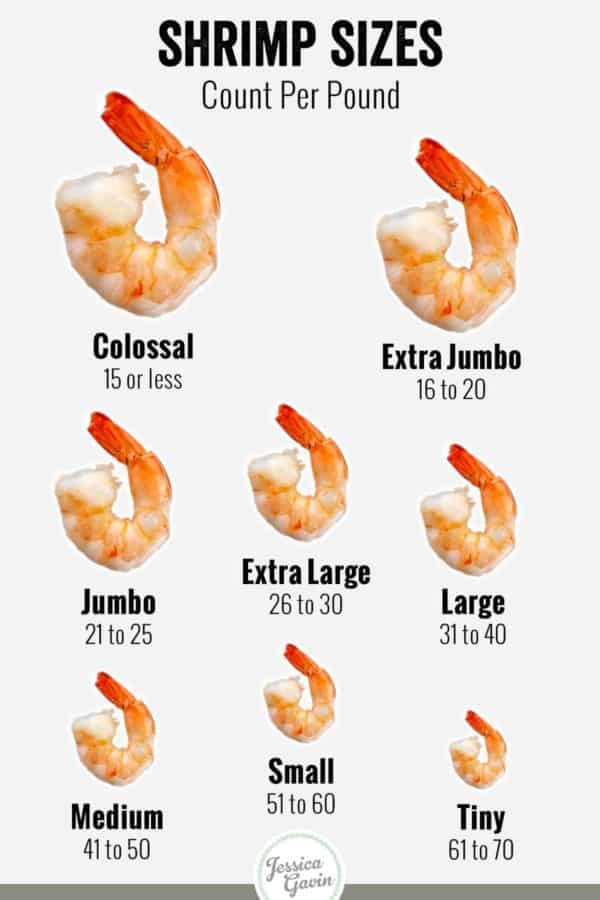Popcorn in a Big Blue Bowl Wif White Shrips
While browsing the seafood section at the supermarket, it may seem like shrimp is just shrimp, but there are actually several types and sizes.

While there are at least 300 species of shrimp in the world, only a small portion are commercially available. They boil down to a few categories: pink, white, brown, and red. That's right, pink shrimp or white shrimp can actually be one of several different varieties.
For example, the white shrimp you see in stores is usually pacific white shrimp or white leg shrimp. Pink shrimp can either be gulf pink shrimp, Maine shrimp, northern shrimp, Oregon pink shrimp, or southern pink shrimp. But despite a wide variety, some are better than others. There are a few red flags to look for and some basic tips that make picking the right shrimp for your dish a cinch.

Standard sizes
When you buy shrimp, whether fresh or frozen, the size designation isn't standard and its best to use count per pound. When you see 41/50 on the packaging of frozen shrimp, that means there are 41 to 50 shrimps per pound. U15 means there are less than 15 shrimps per pound. The fewer shrimps per pound, the larger they are. Here's a quick overview:
| SIZE | COUNT PER POUND |
|---|---|
| Extra Colossal | U/10 |
| Super Colossal | U/12 |
| Colossal | U/15 |
| Extra Jumbo | 16/20 |
| Jumbo | 21/25 |
| Extra Large | 26/30 |
| Large | 31/40 |
| Medium | 41/50 |
| Small | 51/60 |
| Tiny | 61/70 |
| Salad Style | 71+ |
Types of shrimp
- White shrimp: These are on the sweeter side, but tend to taste nuttier than pink shrimp. There are also Chinese white shrimp and Mexican white shrimp which are farmed species and not wild caught (usually less sustainable).
- Pink shrimp: These are the little pink guys you'll typically see behind the seafood counter. They're pink when raw, hence the name.
- Rock shrimp: While they start out in hard shells, they're typically deshelled before they're sold. They're often compared to lobster because of their firm texture, and you can substitute them for lobster as a more affordable protein.
- Brown shrimp: They have a more mineral flavor than white and pink shrimp, and they can contain more iodine. They turn pink once they're cooked and are commonly used in dishes like gumbo.
- Royal red shrimp: Named after their bright red color, they're also often compared to lobster because of their rich flavor and firm texture.
- Tiger shrimp: These little fellas are characterized by their stripes and can actually become quite large, but they tend to be farmed and not very sustainable.
Fresh versus frozen
The shrimp you see behind the seafood counter at large chain grocery stores were all likely individually quick frozen (IQF). IQF is a processing method used shortly after harvesting to keep the eating quality high and ice particles small when stored in the freezer.
Shrimp can also be frozen in large blocks of ice. For the buyer at the market, this means they're just sitting there dethawing before your eyes. Their freshness is an illusion unless called out on the tag, so you're better off buying the frozen packages. The only exception? If you live in an area with fresh seafood close by, you may have a local port or shop that sells truly fresh and live shrimp.

Nutritional facts
According to the USDA food database, 3 ounces of shrimp contains:
- 20 grams of protein
- .24 gram of fat
- .17 grams of carbohydrates
- 60 milligrams of calcium
- 33 milligrams of magnesium
- 94 milligrams sodium
What is sustainable shrimp?
Wild caught shrimp from the United States is the most sustainable. If you did some digging into where your shrimp came from, you'd want it to be caught with small nets and traps (many overseas fishers use massive nets that sweep up anything and everything in their path, destroying other ocean life and habitats). If you see "wild imported shrimp," that's likely how it was caught.
Farmed shrimp imported from overseas is another red flag, likely the result clearing out coastal areas that eventually become polluted due to lack of regulation. Bottom line: If it's imported, it probably isn't sustainable. Seafood Watch is a helpful resource when making sure all your fish is sustainably caught.
Recipes with Shrimp
- Grilled Shrimp Skewers
- Shrimp Scampi
- Shrimp Stir-Fry
View all Shrimp recipes
Filed under: Ingredient Guides Kitchen Tips
This post may contain affiliate links. Please read my disclosure policy.
You May Also Like
Reader Interactions
Source: https://www.jessicagavin.com/types-and-sizes-of-shrimp/


0 Response to "Popcorn in a Big Blue Bowl Wif White Shrips"
Post a Comment